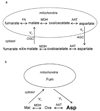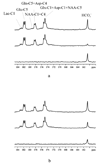Studying Enzymes by In Vivo C Magnetic Resonance Spectroscopy
- PMID: 20161496
- PMCID: PMC2796782
- DOI: 10.1016/j.pnmrs.2009.06.002
Studying Enzymes by In Vivo C Magnetic Resonance Spectroscopy
Figures












Similar articles
-
Use of in vivo magnetic resonance spectroscopy for studying metabolic diseases.Exp Mol Med. 2015 Feb 6;47(2):e139. doi: 10.1038/emm.2014.101. Exp Mol Med. 2015. PMID: 25656949 Free PMC article. Review.
-
Characterization of Brain Metabolism by Nuclear Magnetic Resonance.Chemphyschem. 2019 Jan 21;20(2):216-230. doi: 10.1002/cphc.201800917. Epub 2018 Dec 20. Chemphyschem. 2019. PMID: 30536696 Free PMC article. Review.
-
Current and future applications of in vitro magnetic resonance spectroscopy in hepatobiliary disease.World J Gastroenterol. 2006 Aug 14;12(30):4773-83. doi: 10.3748/wjg.v12.i30.4773. World J Gastroenterol. 2006. PMID: 16937457 Free PMC article.
-
A combined n.m.r. and molecular biological approach to studying enzymes in vivo.Biochem Soc Trans. 1991 Nov;19(4):997-1001. doi: 10.1042/bst0190997. Biochem Soc Trans. 1991. PMID: 1838991 Review. No abstract available.
-
Hyperpolarized 13C-labeled bicarbonate (H13CO3-) for in vivo pH measurement with 13C magnetic resonance spectroscopy.2010 Jan 25 [updated 2010 Apr 12]. In: Molecular Imaging and Contrast Agent Database (MICAD) [Internet]. Bethesda (MD): National Center for Biotechnology Information (US); 2004–2013. 2010 Jan 25 [updated 2010 Apr 12]. In: Molecular Imaging and Contrast Agent Database (MICAD) [Internet]. Bethesda (MD): National Center for Biotechnology Information (US); 2004–2013. PMID: 20641986 Free Books & Documents. Review.
Cited by
-
Interpretation of ³¹P NMR saturation transfer experiments: what you can't see might confuse you. Focus on "Standard magnetic resonance-based measurements of the Pi→ATP rate do not index the rate of oxidative phosphorylation in cardiac and skeletal muscles".Am J Physiol Cell Physiol. 2011 Jul;301(1):C12-5. doi: 10.1152/ajpcell.00100.2011. Epub 2011 Apr 13. Am J Physiol Cell Physiol. 2011. PMID: 21490314 Free PMC article. No abstract available.
-
In vivo detection of intermediate metabolic products of [1-(13) C]ethanol in the brain using (13) C MRS.NMR Biomed. 2011 Nov;24(9):1054-62. doi: 10.1002/nbm.1653. Epub 2011 Feb 11. NMR Biomed. 2011. PMID: 21312308 Free PMC article.
-
Early development of arterial spin labeling to measure regional brain blood flow by MRI.Neuroimage. 2012 Aug 15;62(2):602-7. doi: 10.1016/j.neuroimage.2012.01.005. Epub 2012 Jan 8. Neuroimage. 2012. PMID: 22245338 Free PMC article. Review.
References
Grants and funding
LinkOut - more resources
Full Text Sources

